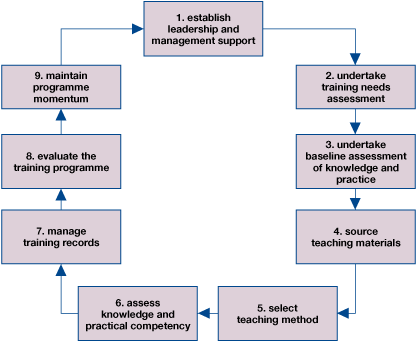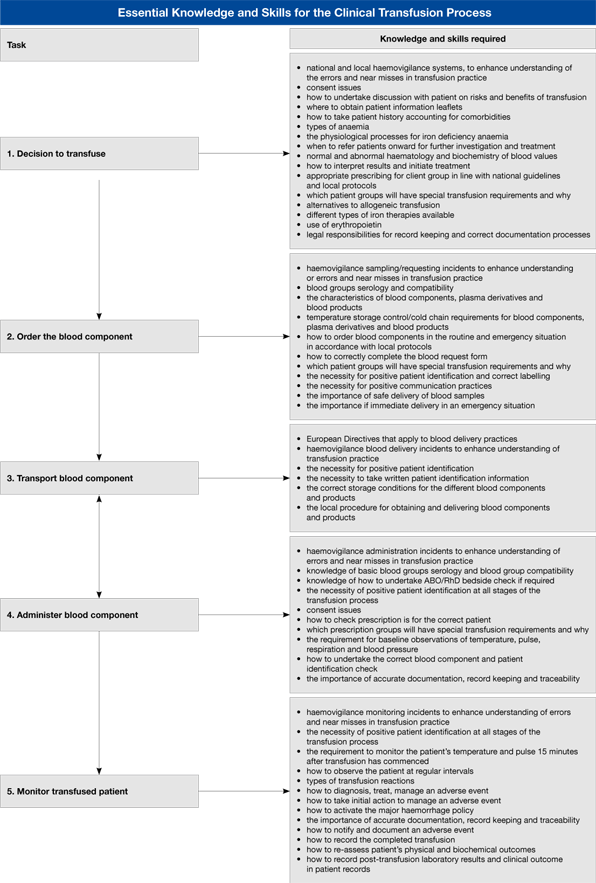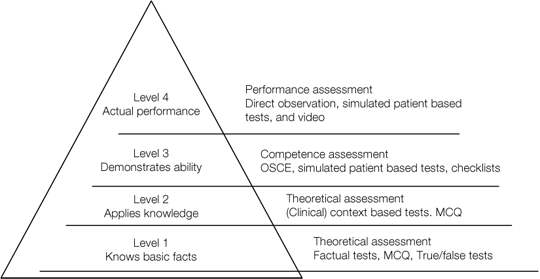10. Training
Directive 2005/62/EC (Annex: 2.1) requires that personnel in Blood Establishments shall be trained and assessed to be competent in the their tasks. This chapter provides an introduction to some of the practical issues that are likely to be encountered if this requirement were to be applied – for example to comply with a national regulation - to all staff who have a role in the clinical transfusion process.
Some of the challenges that may have to be overcome to provide effective training and assessment for hospital staff are:
- The large number of individuals and the range of different employment groups who have some involvement in the process
- Rapid turnover of staff ( for example due to training requirements for clinical staff)
- Working patterns – shiftwork, part time work
- Multiple employers – eg agencies providing nurses and doctors, external contractors for support services
- Language differences due to mobility of personnel within the EU
- Differences in education, training and the details of practice experience of personnel from different member states
Education and training is fundamental to every aspect of blood transfusion safety. The development of guidelines and S.O.P.’s is insufficient to alter clinical practice: they must be used. As well as meeting EU requirements, it is important to comply with any national requirements for training staff involved in transfusion. Although every EU country will have different access to resources and facilities, there are a number of essential steps to consider when implementing an education and training programme in transfusion.
Figure 10.1 Example of the steps for implementing an education and training programme

10.1 Establish leadership and management support
An effective training programme requires leadership and commitment from the senior management of the organisation. They need to be aware of the regulatory requirements of the EU Blood directives together with other national standards for safe and appropriate transfusion practice.
It is essential to have an active multidisciplinary Hospital Transfusion Committee (HTC) that takes responsibility for developing and implementing a strategy for the education and training of all clinical, laboratory and support staff involved in blood transfusion. A lead person should be appointed to oversee the day-to-day running of the training programme and must have access to adequate staffing and resources.
10.2 Undertake training needs assessment
Who needs training in what?
Various staff groups have been identified as involved in the process for transfusing blood in hospitals. Undertaking a Training Needs Assessment (TNA) will help to determine:
- The knowledge and skills requirements for each specific task in the clinical transfusion process
- Which staff groups require training
- How many in each specific staff group require training
- What training is currently available and who is responsible for training of each of the staff groups
- A baseline as a basis for later progress reporting
A template for training needs assessment is provided on the website.
Trainers
It is also essential to review the training needs of the trainers to support and develop their ability, confidence and motivation to deliver effective teaching. Trainers need to maintain their knowledge by continuous professional development. They should have access to courses and opportunities for self-learning. In addition, they should have access to training courses to develop and maintain other specific skills in communication, IT, etc.
10.3 Baseline assessment of knowledge and practice
It is helpful to have data on transfusion practices before the implementation of the education programme. Transfusion practice audits, and reviews of errors and near misses reported to the HTC or the haemovigilance system will provide valuable information on where training and education should be targeted.
The practices that should be audited derive from the activities identified in the essential steps in the clinical transfusion process. (Fig 2.1)
Member States may have different names for similar jobs, and some job titles will not exist in some countries. There are differences among member states and local hospitals as to which staff group undertake particular tasks.
Figure 10.2 identifies the knowledge required for each task. Areas of knowledge and procedures that should be evaluated are:
- Knowledge of blood group serology
- Knowledge of characteristics of blood components
- Procedures for blood sampling and labelling
- Procedures for storage of blood components
- Procedures for collection and delivery of blood components
- Checking and administration procedures for blood components
- Procedures for monitoring the transfused patient
- Understanding of adverse events in transfusion
It is essential to make a realistic assessment of the resources (personnel and financial) required for collecting baseline data and for an ongoing audit programme to ensure standards are being maintained. Each hospital should have a clinical audit department (or a similar function as part of quality management) that should be able to provide advice.
Two methods often used to gather information about existing knowledge and practice are questionnaires and observation of practice.
Questionnaires should reflect the required standards of practice and may differ for each group of staff. While a questionnaire can be a relatively simple way to obtain information, there are known problems. These include poor response rate, deficient completion and the temptation to give the ‘correct’ rather than a ‘true’ response.
Observational audit of transfusion practices can yield very useful information, but is labour intensive and difficult to undertake. Direct observation can make staff alter their practice, however there is evidence to suggest that staff become used to the observer and continue with their usual practice.
Figure 10.2 Essential knowledge and skills for the clinical transfusion process

10.4 Obtain teaching and training material
If you choose to develop your own materials, this will require careful planning and dedicated time. All learning materials should be critically reviewed by subject experts. Due to the large numbers of staff involved in blood transfusion practice, e-Learning education programmes in transfusion have been developed and may be useful in the training programme. However, e-Learning should not be seen as an easy answer, since it requires a comprehensive support strategy.
This must cover the following:
- Access to computers for staff
- Connectivity and bandwidth
- Security of personal information
- IT skills of the learner (consider providing the first e-Learning experience in a facilitated environment)
- Provision of a help line for users and technical support for learners
- Providing step-by-step user guides
- Dedicated time for training.
- Setting up e-learning champions
To access the majority of these e-Learning education programmes, the learner will need an email address and Adobe Flash Player version 8 (or higher). Some English languagelearning sites are given below. See also the list of links at the end of the manual.
Better Blood Transfusion - Continuing Education Programme
www.learnbloodtransfusion.org.uk
Bloody Easy Online Course
http://sunnybrook.nextmovelearning.com
Blood Safe Online Transfusion Course
http://www.bloodsafelearning.org.au/
Learn Cell Salvage
http://www.learncellsalvage.org.uk/
Nursing CE: Blood and Blood Product Administration
www.elearners.com/course/31266.htm
10.5 Select teaching methods
There are several different teaching methods that may be of use in delivering transfusion education. The choice will depend on the target group, the numbers that require transfusion training and the level of training required. Table 10.1 gives a brief description of some of methods.
Table 10.1 Teaching methods
| Method | Description | Pros and cons |
|---|---|---|
| Large group teaching — lectures | Historically the most widely used teaching technique. Very useful for providing training to large numbers of learners who need the same information. Can be supported by handouts to promote call of information. | Inexpensive approach, however, the quality of lecture is dependent on the knowledge, skill and attitudes of teacher, and learners may feel they have a ‘passive’ role with lack of involvement. |
| Small group learning | An interactive learning approach using small group, problem based learning. The trainer has the role of facilitating, prompting and providing guidance and prompt feedback. Medical undergraduate education has moved to this approach in may countries. | This method can be used for multidisciplinary education for key staff involved in transfusion. Promotes active participation, sharing of experiences, and learning from each other. |
| Individual learning | Learning can be self-directed using paper based materials or e-Learning. Should not be used in isolation but integrated into the wider programme. Requires a clear strategy with standardisation of approach. | Learners must have key IT skills and access to IT resources if using e-learning packages. Individual learning is unsuitable for developing practical transfusion skills. |
| Simulated learning | This technique has been adapted for use in healthcare. Can be used to recreate common errors in transfusion practice e.g. ‘wrong blood’ incidents. | Expensive and only suitable for training small numbers per session. |
10.6 Assess theoretical knowledge and practical competency
Directive 2005/62/EC requires that in blood establishments, competence of personnel shall be evaluated regularly (Annex: 2.4). If this principle is to be extended to cover all staff involved in the clinical transfusion process, it will be necessary to consider the points that follow.
The purpose of assessment is to evaluate or measure achievement of learning and competence, and provide information for more effective teaching. There are four stages of development that an individual progresses through from acquiring knowledge to performing a task in clinical practice and these are “knows, knows how, shows how and does”, and each level requires to be assessed differently. See Figure 10.3
Level 1 and 2 theoretical competency
A number of methods can be used to assess the retention of theoretical knowledge following training. These can be paper based or part of the e-Learning programme. The advantage of the e-learning approach is that assessments are scored and recorded online, avoiding time-consuming traditional methods.
Level 3 and 4 practical competence
Formal assessment of clinical competence can be used to integrate theory with practice. Level 3 and 4 are difficult to assess. Issues that have been identified in the UK during the introduction of competency assessment for the clinical transfusion process are:
- The large number of individuals to be assessed.
- Dedicated preparation time is required for the assessor.
- Time must be allocated for the staff to be assessed
- Difficulty in finding clinical situations for assessment
- Cost
Tools for assessing practical competency are available from several organisations: examples of English language versions can be found at the sites below:
http://www.npsa.nhs.uk/patientsafety/alerts-and-directives/notices/blood-transfusions
http://www.skillsforhealth.org.uk
A description of the methods that can be used assess theoretical and practical competency is provided in table 10.2.
Table 10.2 Assessment of knowledge and competency
| Method | Description |
|---|---|
| Background Knowledge Tests | Short, simple questionnaires for use prior to implementing a training programme or introducing an important new topic. |
| Multiple-choice questions (MCQ) | Measures both simple knowledge and complex concepts. MCQ can be answered quickly and can be easily and reliably scored. |
| True-false questions | Are less reliable because random guessing may produce the correct answer. However, they provide a method for recall and can be easily and reliably scored. |
| Matching tests | An effective way to test learners’ recognition of the relationships between words and definitions and categories and examples. |
| Checklist evaluation | Useful for evaluating any competency that can be broken down into specific behaviours, activities or steps that make up a task or procedure. Can also be used for self-assessment of practice skills. |
| Objective structured clinical examination (OSCE) | Assessments are administered at a number of separate standardised patient encounter stations. Each station lasting 10-15 minutes. |
| Live simulated situation | Imitate but do not duplicate real life situations. ‘Actor’ patients or mannequins can be used and scenarios can be administered individually or in groups. They are resource intensive however, and the assistance of technical expertise is required. |
| Computer simulation | Expensive to create, however, provides an opportunity to assess skills without possible harm to live patients. There is exposure to standardised training content and the ability to provide immediate feedback to the learner. |
| Direct observation of practice | Assessment takes place in a real practice setting. Desired or proficiency required in specific behaviours in conducting skill have to be demonstrated. |
| Videotaping a practice session | Seen as a poor assessment technique however, as it captures performance and not competence. |
10.7 Manage training records
Records of training and assessment of B.E staff are required by Directive 2005/62/EC. Suitable records would show for each person that the required training, assessments and updating had been undertaken. A training record should, as a minimum, contain the following information:
- Name of trainee
- Unique identification number
- Place of work
- Date of training session
- Type of training session
- Length of time of training
- Training method
- Name of the trainer(s)
- Evaluation method
- Attainment achieved
- Record of assessment of competence
These principles would also apply to training records for staff involved in the clinical transfusion process.
10.8 Evaluate the training programme
The evaluation of the teaching programme against predetermined goals can help determine the overall effectiveness of several components. This includes participant learning, trainer effectiveness, learning environment, use of resources and organisational impact. The main areas of importance are:
- Educational outcomes — has understanding and retention of knowledge following a training session improved?
- Clinical outcomes — has occurrence of transfusion critical incidents or specific aspects of transfusion practice improved (e.g. patient observation during transfusion, documentation of indication for transfusion in case notes etc.)?
- Qualitative and quantitative feedback by trainees and trainers — can be used to evaluate particular teaching sessions. Questionnaires can be paper based or electronic.
Evaluation by trainees
Areas to evaluate:
- Facilities used for training e.g. venue, access to venue for face-to-face teaching
- Access to IT resources for computer based learning
- Did the teaching session cover pre-defined key learning objectives
- Likely impact or anticipated change in clinical practice
- Quality and content of teaching material
- Quality and content of any handout material
- Quality of teaching method
- Clarity of presentation
Evaluation by trainers
Areas to evaluate:
- Facilities available for training e.g. venue etc
- Key learning objectives clearly defined
- Clear information available regarding training needs of target group
- Training provision for teaching and facilitation skills (‘training the trainer’)
- Resources available for teaching
- Quality of teaching material (learner feedback on slides, handouts etc)
- Accessibility to training (e.g. computer based learning)
10.9 Sustain the momentum of the programme
It is recognised that immediately following training, staff demonstrate higher levels of awareness, motivation and performance, but in time this may decline and bad habits may return to reduce the quality of the work. Suggestions for achieving commitment and maintaining momentum between training sessions are:
- Maintain regular communication with staff
- Be visible
- Use hospital newsletters, hospital intranet, informal teaching/lecturing sessions to promote e-Learning programmes and other learning opportunities
- Set up a network of interested individuals in clinical areas to help disseminate information
- Make sure that protocols and guidelines are available to all the people that should be using them
- Use early feedback to clinical areas of transfusion events or reactions, and lessons learned
- Encourage trainees/learners to provide feedback on training
Implementing a transfusion training and education programme can be very challenging. Finance and facilities may be inadequate to meet the training needs of a large diverse group of staff. Strong and sustained support from management, backed with resources for necessary people and materials is essential.
Table 10.3 Teaching methods
Triangle of knowledge/ clinical skills competence/performance (Adapted from Miller 1980)
